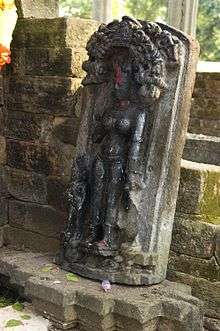Sarak
The Saraks (Bengali: সরাক) (from Sanskrit Śrāvaka) is a community in Jharkhand, Bihar, Bengal, and Orissa . They have been followers of some aspects of Jainism, such as vegetarianism, since ancient times, however were isolated and separated from the main body of the Jain community in western, northern and southern India and have been Hindu Bengalis ever since. The governments of India and West Bengal both have classified some of the Saraks under Other Backward Classes since 1994 but many of them have been in the General category from the beginning itself.[1]
| Sarak সরাক | |
|---|---|
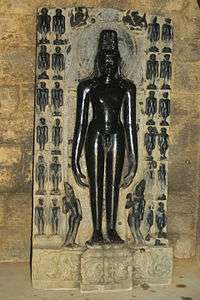 Lord Adinatha at Pakbirra | |
| Religions | Hinduism, Jainism |
| Languages | Bengali, Hindi,Nagpuri |
| Populated states | Jharkhand, West Bengal, Bihar, odisa |
| Part of a series on |
| Jainism |
|---|
 |
|
Jain prayers |
|
Ethics |
|
Major sects |
|
Texts |
|
Festivals
|
|
|
History
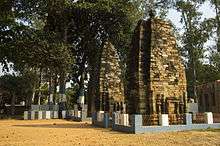
The Saraks are an ancient community in Jharkhand and Bengal. British anthropologist Edward Tuite Dalton noted that according to the Bhumij tradition in Singhbhum district, the Saraks were early settlers in the region.[2] According to Santosh Kumar Kundu, the Saraks arrived from the northwestern region of India, presently in Gujarat and Uttar Pradesh. In the region between the rivers Barakar and Damodar, two democratic republics, Shikharbhum and Panchakot, flourished. Later they merged and came to be known as Shikharbhum, with the capital at Panchakot. According to Ramesh Chandra Majumder, the Jain scholar Bhadrabahu, the second Louhacharya and the author of Kalpa Sutra may have come from the Sarak community.[3] The Saraks were agriculturists and moneylenders having landed properties. Many of their rituals and customs are similar to that of Brahmins. Though the mainstream Saraks are Bengali Hindus, yet they have a touch of Jainism.
They have continued to remain vegetarian even though this practice is uncommon among other communities in the region. Saraks have Parshva as a favored patron and recite the Ṇamōkāra mantra. They revere both Hindu and some Jain idols.
The region is called Vajjabhumi in ancient texts because diamonds were once mined in the region.[4] The Tirthankara Mahavira visited this region according to the Kalpa Sūtra. The low profile ‘Sarak’ solely depends on agriculture for their livelihood. One can see numerous youngsters carrying axe in their hands who are unaware of the modernity of the progressive society. On one hand where we feel highly responsible towards Indian values, there were ‘Saraks’, who were not even acquainted with education, technology and art. Peaceful and simple by nature, ‘Sarak’ people claim with proud that none of them have ever been to jail for committing any kind of crime. They are well accomplished in the art of arbitration and do not believe in any kind of violence. They do not even use words like, ‘kill’ or ‘cut’ in their daily conversation. They celebrate Durga Puja, other Hindu festivals as well as Jain festivals like Mahaveer Janam Kalyanak.
A group of Saraks from northern parts of Purulia district migrated to the Subarnarekha valley and established a small state by the name Ruam. There is a village existing by the same name in Musabani Block of East Singhbhum district very close the Uranium town of Jaduguda. They are the people who started mining of Copper ore for the first time in Singhbhum Shear Zone which is now famous for mining of precious metals such as Copper, Gold, Silver and Uranium. The Saraks of Ruam also mastered the art of smelting of copper. It is also evident that famous ancient port of Tamralipta owes its name to the copper mined and processed in the Sarak country of Ruam which was exported to the South East Asian kingdoms in a large scale.
Separation and rediscovery
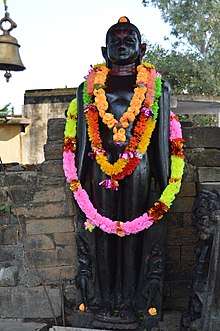
The Saraks lost contact with Jains in the rest of India after its conquest by Ikhtiyar Uddin Muhammad bin Bakhtiyar Khilji. Contact with the Digambara Bundelkhand Jains was reestablished when the Parwars Manju Chaudhary (1720–1785) was appointed the governor of Cuttack by the Maratha Empire.
Saraks are concentrated in Purulia, Bankura and Burdwan district of West Bengal and Ranchi, Dumka and Giridih districts and Singhbhum region of Jharkhand. The Saraks belonging to most of Jharkhand and West Bengal are Bengali speakers while those living in historical Singhbhum region speak Singhbhumi Odia. Educated Saraks speak fluent English.
In 2009, more than 165 Sarak Jains living in parts of West Bengal, Jharkhand and Bihar visited the ancient Jain pilgrimage center of Shravanabelagola. A special function to welcome the Sarak Jains was organised at Shravanabelagola.[5]
A social organization called, 'Sarak Samaj Unnayan Samity' is working for the welfare of sarak community. Its main goals include eradicating dowry system from the Sarak community. Open-mindedness and good principles are the traits of this community. They are into Bengali Literature, Art, Music and Dance and are nowadays also enjoying western concepts of culture.
Professions
In the past they were engaged in copper mining in the region.[6] Most Saraks were farmers engaged in rice cultivation, dairy farm selling milk products. Some of them have shops related to agriculture. Many are well educated. There are many teachers, engineers, doctors,professors,MBA and Civil Servants in this community.
List of villages
- Basudih
- Bhuli
- Rupnarayanpur
- Beriathol
- Ledapalash
- Kansai
- Pairasol
- Pabra
- Duburia
- Bishjor
- Dhekia
- Patdoha
- Binoddihi
- Sidabari
- Udaypur
- Dhadkidih
- Mohula
- Upardih
- Ichar
- Bagicha
- Jhapra
- Patharbandh
- Kanshibera
- Mongram
- Gobindapur
- Senera
- Khajra
- Antumajirdih
- Laragora
- Bhagabandh
- Gourangodih
- Metyalsahar
- Raghunathpur
- Nanduara
- Gobindapur
- Ekunja
- Beniasole
- Gosaidanga
- Nutandih
- Durmat
- Bathan
- Kanchkiyari
- Naragoria
- Ghutitora
- Kelahi
- Simlon
- Khajura
- Upar Khajura
- Layekdanga
- Senera
- Sikratanr
- Lachmanpur
- Jumduara
- Bero
- Puraton Bero
- Bagicha
- Kanthalbero
- Brindabanpur
- Kalapathar
- Panchmahali
- Upar Panchpahari
- Nama Panchpahari
- Biltora
- Dhanardanga
- Bangsagram
- Gobag
- Lachiya
- Janardandi
- Hetabahal
- Patharbandh
- Sarapdhar
- Talajuri
- Mohulkoka
- Indrabil
- Gourangdih
- Babirdih
- Rajra
- Murlu
- Radhamadhabpur
- Bodma
- Lalpur
- Metyalsahar
- Bhagabandh
- Kashibera
- Managram
- Barda
- Sundrabandh
- Paranpur
- Alkusa
- Fuliddi
- Choutala
- Mahula
- Palma
- Banbera
- Nimbayd
- Soyar
- Jhapra
- Jabarra
- Sankra
- Para Kelyahi
- Bagatbari
- Fusrabaid
- Asanbani
- Layara
- Ichhar
- Upardih
- Kamargora
- Khamarmahul
- Santaldih
- Balichasa
- Dhadkidi
- Tatogram
- Amchatar
- Bahara
- Darda
- Putlya
- Thakurdih
- Surulia
- Bathanbari
- Bhandarkuli
- Kantabani
- Lakhipur
- Churmi
- Mahal
- Bhajudi
- Choudhuri Bandh
- Shibbabuddi
- Asansole
- Gandharbadih
- Salkunda
- kundahit
- Bindapathar
- Parbatpur
- Uparbandha
- Karmatanr
- Debogram
- Postabari
- Belut
- Belanga
- Kumardih
- Gosaidih
- Lachhmanpur
- Gangajalghati
- Kendrabona
- Bhuinphore
- Balikhun
- Rajamela
- Lachhmanpur
- Haribhanga
- Mallikdihi
- Bhaktabandh
- Chholabaid
- Deshuria
- Chururi
- Barkona
- Bajapathar
- Moulahir
- Sahebdanga
- Khagra
- Jirrah.
- Indrabil
- Bundu
- Tamar
- Ranchi
- Khunti
- Torpa, kashmar
- Dorma, korla
- Mahil,Meral
- Biramkel
- Hansha
- Norih
- Rahe majhidih
- Paramdih
- Sobahatu
- Hundih Nawadih
- Tarai
- Rangamatti
- kharsawan
- Domohani
- Lalbazar
See also
- Śrāvaka (Jainism)
- Jainism in Bengal
- Basudih
- Purulia District
- Sarak(Jainism,Hindu)
- Ranchi District
- khunti District
- Karshawa District
- Salkunda( jamtara district)
Pakbirra, Purulia Temples and Sculptures
 Divine couple with child, Pakbirra, Purulia
Divine couple with child, Pakbirra, Purulia Sahasrakuta, Pakbirra, Purulia
Sahasrakuta, Pakbirra, Purulia Miniature shrine, Pakbirra, Purulia
Miniature shrine, Pakbirra, Purulia Miniature shrine, Pakbirra, Purulia
Miniature shrine, Pakbirra, Purulia Adinatha Idols
Adinatha Idols Miniature shrine, Pakbirra, Purulia
Miniature shrine, Pakbirra, Purulia- Miniature shrine, Pakbirra, Purulia
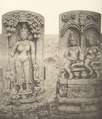 Jain Sculptures at Pakbirra
Jain Sculptures at Pakbirra
References
- "Government of West Bengal: List of Other Backward Classes". Govt. of West Bengal. Retrieved 23 December 2011.
- Ghosh, Binay (2010) [1957]. Pashchimbanger Samskriti [The Culture of West Bengal] (in Bengali). 1 (2nd ed.). Kolkata: Prakash Bhawan. pp. 447–449.
- Kundu, Santosh Kumar (2008). Bangali Hindu Jati Parichay [An Introduction of Bengali Hindu Castes] (in Bengali). Kolkata: Presidency Library. pp. 273–275. ISBN 978-81-89466-13-8.
- Historical Background (Archived 9 December 2009 at the Wayback Machine)
- "> News Updates". Www.Jainheritagecentres.Com. 2 September 2009. Archived from the original on 23 December 2015. Retrieved 19 May 2012.
- Prof. V. Ball, 1868, Geological Survey of India
